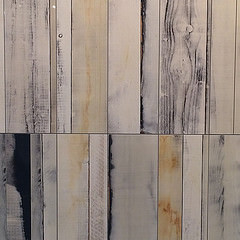Faux Wood for Real Homes
 The handsome look of wood is enduringly popular as a building material or a décor accent. Features such as rustic ceiling beams are very much on-trend. However, natural hardwood, charming as it may be, is not always the most practical or affordable option.
The handsome look of wood is enduringly popular as a building material or a décor accent. Features such as rustic ceiling beams are very much on-trend. However, natural hardwood, charming as it may be, is not always the most practical or affordable option.
Take a good long look at today's faux woods – they just might turn out to be the best choice for your flooring, deck, or decorative beam or panel project. Interesting faux wood fact: What most people think of as "fake" often contains a high percentage of real wood, usually in the form of recycled pre-consumer waste. It can be a surprisingly eco-friendly alternative.
Flooring
The most common type of faux wood used as flooring is laminate. This consists of several layers, including a moisture barrier on the underside, a layer of recycled wood fiber, a veneer (or a photograph in less expensive varieties) of real hardwood, and a melamine finish on top.
Laminate has quite a few advantages. It costs substantially less than hardwood, making it easier on your budget even if you live in the famously expensive DC region. As well, Washington laminate flooring installation is simpler and often may be done without removing the old floor. Durable, with good scratch-, sun- and moisture-resistance, laminate is easy to maintain, requiring no polishing, and will stand up to wheelchair use much better than hardwood. Look for a guarantee of 15 to 25 years.
There are a number of areas where laminate does not stack up to real hardwood, though. The first is in terms of looks – laminate, especially the cheaper versions, lacks the beauty and depth of authentic wood. It can be complicated to mend, since it can’t be sanded. Manufacturers do sell touchup and repair kits, though. If the laminate is made up of individual planks, replacing a damaged piece is simplified.
On the green front, laminate relies on rapidly renewable resources, and makes use of a higher percentage of each tree than traditional hardwood harvesting. The installation process does not require adhesive. On the other hand, laminate flooring may give off dangerous volatile organic compounds (VOCs), even formaldehyde. Ventilate well during, and for some time after, installing, and then seal the floor. Look for material produced in compliance with the American National Standards Institute (ANSI).
Decks and Railings
Faux wood for outdoor living spaces, such as decks, porches, and railings, is cheaper and easier to install than regular hardwood. Harder-wearing and longer-lasting, it stands up to extremes of heat and cold as well as rain and other forms of precipitation. And, of course, it is not as tasty to termites as natural wood.
In appearance, a faux wood porch can’t compete with a glorious redwood deck, but this material is gradually being produced in better-looking forms.
Environmentally friendly faux wood decking is a composite, which is generally made from those soda bottles, milk jugs and plastic bags that conscientious consumers faithfully send to the recycling bin. Newer versions include some wood fiber, too.
Ornamental Beams, Panels and More
Ceiling beams are back in fashion in a big way. These ornamental touches, together with fireplace mantels, exterior siding, and wall or ceiling planking, allow you to give your home the look of a log cabin (complete with realistic-appearing ax marks, if you wish!) or Shakespeare’s half-timbered Tudor home. When manufactured from faux wood, they can be made to imitate various upscale species of lumber.
Faux wood beams and panels are cheap, lightweight and easy to lift and to install. They may be cut with a simple handsaw; they can also be painted or stained. The beams are built three-sided, with an open channel that is ideal for concealing HVAC ducts and vents. Repair is simple – cracks can be splinted and glued, while gaps and holes may be mended with wood filler or caulk.
The downside of this type of imitation wood is that it is generally made from vinyl or polyurethane. These were known in the past for their tendency to offgas, endangering indoor air quality and causing health problems such as respiratory difficulties. However, manufacturers have begun creating some types of vinyl that are much lower in VOCs and therefore more eco-friendly.
Laura Firszt writes for networx.com.
Updated September 16, 2018.
Looking for a Pro? Call us (866) 441-6648

Heating & cooling Average Costs
HVAC Contractors Experiences

My Deck Repair Was Simple But Perfect

No Budget For A New Deck This Year? Try This Affordable Option



